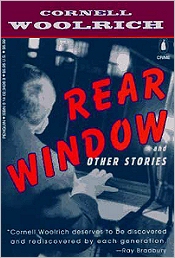 |
"Rear Window"Cornell Woolrich |
|---|
 |
"Rear Window"Cornell Woolrich |
|---|
Cornell Woolrich, who wrote the story "It Had To Be Murder" on which Rear Window was based, was somewhat bitter about having been paid such a small amount for the story. It was one of eight stories in a collection sold by his Hollywood agent, H.N. Swanson, in the 1940s for $5000; it was not optioned--meaning that more money would be paid if a movie was actually produced--but sold outright, so the author would never be owed any further payments. But what angered Woolrich even more than the miniscule payment was that Hitchcock did not invite him to the premiere showing of the movie in New York. "He knew where I lived," he told Barry Malzberg. "He wouldn't even send me a ticket."
He may not have made much money on the deal, but it was the first time a Woolrich story was transformed by an unarguably world-class director into a film so captivating that whole chapters of books have been devoted to its explication. Rear Window (1954) was directed by Alfred Hitchcock from a screenplay by John Michael Hayes, starring James Stewart as Jeffries and Grace Kelly as his fashion designer girlfriend Lisa Freemont. Thelma Ritter was featured as the friendly-snooping nurse Stella, Wendell Corey as skeptical but open-minded Lieutenant Doyle, and Raymond Burr as Thorwald.
In preparing Rear Window, Hitchcock and Hayes had to find a way of turning a short story into a picture that would hold the attention for two hours' running time. This they accomplished by integrating into the movie a host of major and minor characters and an abundance of themes that were either absent from the Woolrich story or barely hinted at, while at the same time keeping the story's plot structure almost exactly as Woolrich had put it together. The measure of Hitchcock's genius is that the fusion of new and genuinely Woolrichian elements produced not a patchwork but a beautifully unified film.
The characterizations owe very little to the Woolrich story. The Jeffries in print is not only a man immobilized but, like so many Woolrich protagonists, a man alone. As visualized by Hitchcock and portrayed by Stewart, Jeffries is a stunningly complex character; as drawn by Woolrich he's virtually a blank slate, with no one even to talk to except the compassionate black houseman Sam whom Hitchcock drops from the film. But by adding the Grace Kelly and Thelma Ritter characters, who have no couterparts in Woolrich, and by expanding Wendell Corey's role as the police detective, Hitchcock opened the door to the network of relationships which distinguish the Stewart character in the picture.
On the level of plot Hitchcock followed the story quite closely, keeping intact the springboard situation, the did-he-or-didn't-he oscillations, and the hair-raising suspense climax. But thanks to all the nuances of theme and character and mood that he grafted onto the story's structure--including the rleationship between Stuart and Kelly, the heat wave, and the steady stream of light bantering dialogue with dark implications--Rear Window the movie evolved into something worlds removed from "Rear Window" as Woolrich wrote it: richer, lighter, deeper, less obsessive and claustrophobic, but no less suspenseful.
--FRANCIS M. NEVINS JR., from Cornell Woolrich:
First You Dream, Then You Die.
A selection of "Rear Window" related fiction.
|
Find "Rear Window" on eBay.com
A selection of "Rear Window" related non-fiction.
|
|
home: The Film Noir 'net |
back to: NOIR LITERATURE |
|
Any comments, additions or suggestions
should be addressed to: The Film Noir 'net / Eric B. Olsen / ericbolsen@juno.com |
Other Web Sites:
History of Horror Hard Bop Homepage The War Film Web Author Eric B. Olsen |